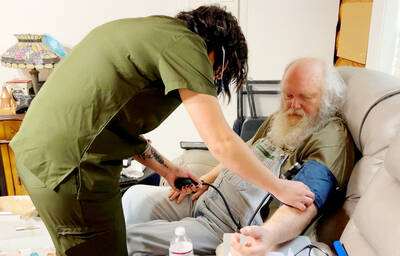Got Threads has plenty of just that — clothing and accessories — but it sets itself apart from neighboring boutiques in the East District (東區) with its green philosophy. The six-month-old store sells a mixture of new and secondhand clothing and doubles as a space for clothing swap parties.
Owner Viona Seshadri (葉家瑋) was inspired by Buffalo Exchange, a US chain that sells secondhand clothing bought directly from its customers. She worked part-time at its Austin, Texas, location while a university student and then as a full-time buyer for two years in Seattle.
The nearly three years she spent working for Buffalo Exchange was a learning experience, says Seshadri. Not only did she become familiar with vintage clothing, but she also caught up on American pop culture.
“Before then, I didn’t know about Kurt Cobain because I didn’t grow up in the US, but when I was a buyer for Buffalo Exchange I saw Nirvana T-shirts,” says Seshadri. “It was a lot like when I studied art history and we had to deduce an artist’s background from a painting. I feel like clothing represents culture in the same way.”
Got Thread’s carefully edited selection of merchandise is sourced from vintage and secondhand stores in the US and Japan, as well as clothing brought in by customers here in Taipei and sold on consignment. Seshadri spends half of each year in the US, where her husband lives. On each trip, she invariably makes a stop at the famous Rose Bowl Flea Market in Pasadena, California, waking up at 5am to beat the crowds.
Though Got Threads takes its inspiration from Buffalo Exchange, Seshadri says that Taiwanese consumers look at vintage clothing differently than their American counterparts. In Taiwan, the term “vintage” connotes a certain style (right now, it’s 1980s-inspired clothing), while secondhand stores usually mean consignment boutiques that sell name-brand bags or shops that specialize in imported jeans and T-shirts from the US. “I wanted to do something that would be in the middle,” says Seshadri, adding that she wants to build a type of secondhand clothing store that is unique to Taiwan.
Got Threads’ concept is relatively novel in this country, but the store has built a base of repeat customers and garnered attention from stylists and celebrities since opening last August. Last week, actress and model Jo’elle Lu (陸明君) dropped by with a couple bags filled with clothing.
Since most Taiwanese consumers shy away from copying period looks literally, Seshadri seeks out clothing that combines contemporary lines with vintage flair. Items in the store include a pair of Salvatore Ferragamo loafers from the 1980s for NT$2,980, 1970s dresses found in Japan, and designer jeans by True Religion and J Brand for NT$3,600 to NT$4,500 per pair (a third of their original price).
“We want to encourage customers to use what they wear to express their backgrounds and points of view,” says Seshadri. “You might carry a designer purse, but you could also have on something that you inherited from your grandmother and a jacket from Zara. What results is your own style.”
Seshadri’s own sartorial sensibility embodies this eclecticism. Last Saturday, she had on a mixture of pieces from a vintage clothing store, Buffalo Exchange and a J Brand jeans sample sale. Her favorite magazines include Nylon and Japan’s Fudge, but Seshadri also reads the Taiwanese editions of Vivi and Mina to keep abreast of current trends in this country. The store’s blog, gotthreads.blogspot.com, regularly posts links to style blogs like The Sartorialist (thesartorialist.blogspot.com), Style Rookie (tavi-thenewgirlintown.blogspot.com, by 13-year-old fashionista Tavi Gevinson) and Nubby Twiglet (www.nubbytwiglet.com).
Got Threads also serves as a space for clothing swaps. Parties where people gather to exchange their used clothing, shoes and other items have gained traction in the US thanks to the slumping economy and increasing environmental awareness, but are still rare in Taiwan. The store hosted two shoe swap parties last weekend, and Seshadri plans to have at least one similar event per season.
“We hope we can encourage people to focus on quality over fashion,” she says. “Buy good quality so that it lasts and buy good quality so you can sell it instead of throwing it away.”

When Taiwan was battered by storms this summer, the only crumb of comfort I could take was knowing that some advice I’d drafted several weeks earlier had been correct. Regarding the Southern Cross-Island Highway (南橫公路), a spectacular high-elevation route connecting Taiwan’s southwest with the country’s southeast, I’d written: “The precarious existence of this road cannot be overstated; those hoping to drive or ride all the way across should have a backup plan.” As this article was going to press, the middle section of the highway, between Meishankou (梅山口) in Kaohsiung and Siangyang (向陽) in Taitung County, was still closed to outsiders

President William Lai (賴清德) has championed Taiwan as an “AI Island” — an artificial intelligence (AI) hub powering the global tech economy. But without major shifts in talent, funding and strategic direction, this vision risks becoming a static fortress: indispensable, yet immobile and vulnerable. It’s time to reframe Taiwan’s ambition. Time to move from a resource-rich AI island to an AI Armada. Why change metaphors? Because choosing the right metaphor shapes both understanding and strategy. The “AI Island” frames our national ambition as a static fortress that, while valuable, is still vulnerable and reactive. Shifting our metaphor to an “AI Armada”

The older you get, and the more obsessed with your health, the more it feels as if life comes down to numbers: how many more years you can expect; your lean body mass; your percentage of visceral fat; how dense your bones are; how many kilos you can squat; how long you can deadhang; how often you still do it; your levels of LDL and HDL cholesterol; your resting heart rate; your overnight blood oxygen level; how quickly you can run; how many steps you do in a day; how many hours you sleep; how fast you are shrinking; how

US President Donald Trump may have hoped for an impromptu talk with his old friend Kim Jong-un during a recent trip to Asia, but analysts say the increasingly emboldened North Korean despot had few good reasons to join the photo-op. Trump sent repeated overtures to Kim during his barnstorming tour of Asia, saying he was “100 percent” open to a meeting and even bucking decades of US policy by conceding that North Korea was “sort of a nuclear power.” But Pyongyang kept mum on the invitation, instead firing off missiles and sending its foreign minister to Russia and Belarus, with whom it